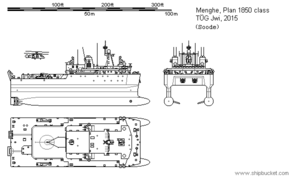Plan 1850 ocean surveillance ship
 3-view diagram of TŬG Jwi in 2015.
| |
| Class overview | |
|---|---|
| Operators: | Menghe |
| Preceded by: | Plan 1828 ocean surveillance ship |
| Built: | 2010-present |
| In commission: | 2013-present |
| Planned: | 12 |
| General characteristics (Jwi, 2015) | |
| Type: | Armed ocean surveillance ship |
| Displacement: | 5,000 tons standard |
| Length: | 86.9 m overall |
| Beam: | 30.2 m overall |
| Draught: | 8.84 m |
| Propulsion: | |
| Speed: | 16 knots |
| Range: | 8,000 nautical miles (1,500 km) at 10 knots |
| Complement: |
|
| Sensors and processing systems: |
|
| Electronic warfare & decoys: |
|
| Armament: | 1 × GBM-23/5_Bulkkot CIWS |
| Aircraft carried: | 2 × GH-28 Ppulsoeori |
| Aviation facilities: |
|
Plan 1850 is the design designation for a type of armed ocean surveillance ship designed and built in Menghe. They are sometimes known as the Jwi class. In addition to a low-frequency active sonar and advanced towed sonar array, they carry self-defense armament and a hangar for two helicopters. The class is still in production, with an estimated total order of 12 ships.
Design
Plan 1850 is unique among ocean surveillance ship classes in that it is a combat-capable warship rather than an unarmed or civilian auxiliary. It has two Bulkkot CIWS mounts on the superstructure, providing full 360-degree coverage with two-gun overlap to a 90-degree arc on either side. It also includes a large hangar capable of supporting two Gyundoan-Han GH-28 Ppulsoeori anti-submarine helicopters, and a landing pad large enough to support heavier aircraft. Baram-2 chaff/flare dispensers, Manhwagyŏng torpedo countermeasure launchers, and a Sŏlpung ECM suite provide additional soft-kill protection against air and sub-surface weapons. Pintle mounts on either side of the bridge can support 12.7mm or 7.5mm machine guns.
This heavy armament reflects the intended role of the Plan 1850 class. Rather than simply tracking submarines in peacetime and measuring their acoustic signatures, these warships were designed to patrol the eastern side of the Strait of Portcullia in wartime, under the threat of attack from either shore. While in practice they would almost always be paired with an escort carrying surface-to-air missiles and anti-submarine missiles, the additional armament provides an extra layer of defense against missiles or torpedoes which make it past the escort's screen.
Like the preceding Plan 1828 class, the Plan 1850 uses a small-waterplane-area twin hull to minimize noise and increase stability. It is, however, substantially larger, measuring 86.9 meters from the aft lifting equipment to the underwater protruding hull sections. An integrated electric propulsion system further reduces noise, but because the powerplant is considerably stronger at 8,000 kW, top speed is higher, at 16 knots.
Despite their increased combat capabilities, the Plan 1850 class are still best thought of as force multipliers rather than warships. This role was confirmed when the Menghean Navy revealed that the type designation would be TŬG (experimental undersea surveillance ship) rather than DChT (special anti-submarine patrol ship) as initially speculated. Their most valuable capability is a low-frequency active sonar array which is suspended vertically from the space between the twin hulls to a depth of about 200 meters underwater, possibly more with an extended cable. Combined with a towed listening array, this antenna produces highly sensitive sonar readings at a long range. Onboard helicopters allow the ship to independently investigate and engage long-range sonar contacts, though it would mainly transmit targeting information to other ships and aircraft.
Ships in the class
Starting with TŬG Jwi, Plan 1850 ships are named for the animals of the Menghean zodiac. This naming scheme implies that a total of 12 ships are planned, an unusually large production run for a large acoustic surveillance ship.